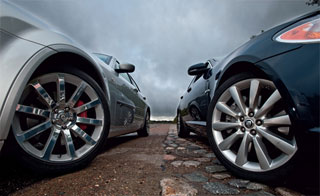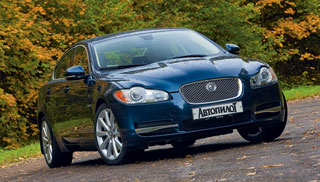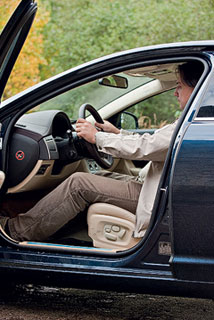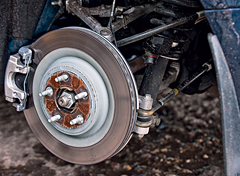Jaguar XF test drive since 2012 sedan
Family values
 Fashion is an unstable thing, fleeting and fleeting. However, in an incredible pile of prete-a-port, there are sometimes things worthy of taking a place in the art galleries (in our case, more than technical). Yes, after some time they are washed off by a muddy wave of assertive pop art, but we know: the true values \u200b\u200bwithstand the test of time. And if something is worthy of a new reading, then it returns. Moreover, all the same thing happens with cars ...
Fashion is an unstable thing, fleeting and fleeting. However, in an incredible pile of prete-a-port, there are sometimes things worthy of taking a place in the art galleries (in our case, more than technical). Yes, after some time they are washed off by a muddy wave of assertive pop art, but we know: the true values \u200b\u200bwithstand the test of time. And if something is worthy of a new reading, then it returns. Moreover, all the same thing happens with cars ... THE AMERICAN DREAM
In the postwar years, the British chased over the unnecessary airfields, and in the USA in the NASCAR series, oval routes had already appeared by that time. The first of them - Daytona Beach Road Course - took the first start in 1903 at all. Nobody offended a craving for competitions in cars in cars: the stands were constantly full, and the boys begged an extra quarter from their fathers to buy a ticket and enjoy the roar of powerful engines. Now imagine: in the yard - 1955, that from the receivers, that is the One's All Right, Mama Elvis Presley (then not the king at all), and ships on wheels with the still starting to be indicated by keel are swimming along the streets. It was a time of rock and roll, when the guys in oiled overalls rolled out frantic hot-rods from their garages, collected from ironings from a landfill based on pre-war Ford and Chevrolet.
Meanwhile, in the special training workshops, Chrysler was in full swing work on creating a 300-horsepower car capable of competing with Chevrolet Corvette in the class of standard cars. Yes, yes, you guessed correctly: the number 300 in the name of the entire letter series appeared from here. This is nothing more than the designation of the FirePower V8 Hemi 331 (5.4 l) engine, installed under the hood Chrysler. Moreover, according to the plan, only 225 such cars necessary for homologation and admission to participate in national racing series should be produced. But who knew that the result of the efforts of the designer Virgil exner, who took as many as four different models of Chrysler and built the S-300 actually by gluing the front part from Chrysler Imperial with the middle of the New Yorker and the back of Windsor using the finish and bumper from Town And country will be so in demand.
The car struck the audience primarily a cab visually shifted forward (Axner did so for reasons of aerodynamics and weightlifting, and it looked really fresh and elegant). As a result, the combination of the V8 Hemi engine, a unique style and light in races did its marketing business, and instead of 225 cars were sold almost eight times more, namely 1725 pieces! Such success should be developed, and the letters of modifications began to be added to the number 300. 300C appeared in 1957, and this was the most successful year for the letter series. Developed fins in the back, a powerful grille of the radiator, double headlights and, of course, the new V8 Hemi 392 with a volume of 6.4 liters, which produced 375 or 390 hp. Depending on the configuration. For a minute, this is 1957! The era of Maskl-Karov has not yet begun, but what they began to put under their hoods has already been created: crazy V8, which later swayed the world with their uterine-rolled roar. And here he is right in front of me, sparkling with silver sides and beckoning the abbreviation of Hemi. He is back. Powerful, stylish, real ...
Do you think that the path of reincarnation is thorny only for a deeply believing Hindu? And how do you like this theory of car reborn? It is unlikely that today someone remembers such a name as Jugo (who answered positively does not count, I just do an eyeliner for the next issue). Now imagine a worldwide presentation under the motto: the grandiose return of the legendary Jugo Florida car. Does not work? It is understandable - Jugo Florida has not accumulated so much positive karma (Jugo is Zastava’s trademark, which produced strongly outdated models of Fiat and Citroen in the Balkans). All this is me to the fact that there are cars, the next embodiment of which will look like a trolley from a supermarket (in fact, it will be a cart), but there are those that are reborn into modern forms, preserving not only the name, but also most of the generic features. The latter, without a doubt, include our guests today. So, meet: the Chrysler 300C SRT-8 and Jaguar XF 5.0 froze at the entrance gates of the Dmitrovsky auto policy. Two classic (almost said family) sedan. Eight doors, ten seats, two roomy trunk, four drive wheels (and all the rear), 816 hp. and 1084 Nm of torque. Such family values \u200b\u200b...


300C Americans nicknamed New ShoeBox, rightly believing that the Chrysler flagship was based on not only the historical motifs of the 1957 model, but also the curtsy towards the box-of-the-air design of the 80s. And the low Bumpers SRT-8 only emphasize the elaborate angularity of the shapes of this car.


Rare knitting needles of 20-inch wheeled wheels literally flaunt one of the main trousers of the SRT-8 brake mechanisms of Brembo. Schild, which issues 300C belonging to the class of sports sedans, is so small and a discreet that it is just right to talk about his modesty.
Two poles
To say, we are already accustomed to the roughly chopped Chrysler 300C forms. But so far only civil versions of the car have been officially delivered to Russia. They even managed to become familiar, but the SRT-8 clearly stands out from the total mass of new letters. Low CO bumers slightly protruding forward by an aerodynamic lip, 20-inch wheels with Brembo red brake calipers, double exhaust and unobtrusive SRT-8 naval brake calipers-that, in fact, are all the differences. But they transform the car so much that there is no doubt about belonging to the clan of the most powerful Chrysler.
But Jaguar XF is not like that. He seems to try to balance between the historical component and ... Japanese sedans of the upper class. That is, with a cursory gaze, its form resembles Lexus LS, but it is worth it to take a closer look at how the features of the classic Jaguar of the late 50s-early 60s come in. This is a characteristic disprovenous look of the headlights stylized as Mark I, and the lines of the body resembling the early XK, and the hooding of the hood sliding to the stylized radiator grill. And with the modern Jaguar line, it is distinguished by the design elements like gills of the ersatz-carriers on the front wings and the characteristic Yaguar design of the new wave. In general, both cars clearly hint at their ancestors, while remaining modern and attractive.
Contrary to all external prerequisites, the internal space of both cars no longer causes nostalgia. True, the differences in the British and American approaches to the concept of the combination of sports style and comfort are so strong that they do not leave the points of contact. I’m even lost at some point ... On the one hand, Chrysler 300C SRT-8 is still a special version, and the buyer first of all should be fascinated by the red inscription Hemi on the engine, not decoration materials. On the other hand, its leather chairs are practically racing buckets with a special PREFFERED SUEDE microfiber filler designed to automatically form a kind of lodgent for the driver. And in general, the SRT-8 salon gives rise to very ambiguous associations. Plastic, as in a cheap Korean car, while all sorts of handles and switches are made at the highest level. But you touch the place, and ... the magic suddenly disappears (something thunders from behind). In a word, America ...
In Jaguar XF, the rate is made for sports of a different kind. Its salon resembles a classic GT, not a body of the body championship. And cats have always taken their technical equipment. And you know: when the light of salon light lights up in response to a light touch to it, and when the ignition is turned on, some mysterious aluminum segments on the torpedo set in motion, opening the air ducts of the climatic system, it fascinates. And the materials used are an order of magnitude better and more expensive than that of a competitor. For all that, I would not say that XF is very better - it is just completely different. You will no longer sit in it rakhabisto in the rapper outfit. The dress code, you know, somehow forms by itself.


Before us is a vivid example of aerodynamic design, making cars similar to each other. The Jaguar XF body slightly resembles all competitors at once, but at the same time stands out favorably with elegant borrowings from its own history.

The whole modern Jaguar line operates the same design solutions on completely different cars, thereby ensuring their one hundred percent recognition. For example, the characteristic patented design of the wheel discs and gills of pseudo -air intakes we can see both on the fast XF sedan and on such a typical GT as XKR.
Jaguar Mark II of 1962.
The story of one Englishman
And what English does not like fast driving? I'll tell you: no. That is, everyone loves unconditionally. It is no coincidence that British boys have been wiped with pants on the stands of racing tracks, of which in the old woman of England, the pond pond in the old women of England. In the first approximation, the reasons for this are as follows: the United Kingdom was actually the whole world world, which was protected from FAU and Junkers raids, or acting as an airfield of American B-17, which regularly delivered their deadly cargo to Germany. So, after the end of the war in the territory of this island state, there are many airfields left that are completely unsuitable for modern aviation, but very cool for car races. And if there is, where to drive, then why not do this? At first, they went to everything that came to hand, but by the end of the 50s the welfare of the British who had recovered from the war began to grow rapidly. And with a full pocket of money, the devil knows what is no longer interested in. As a result, firms producing sports class cars began to appear literally dozen. The recipe for a typical English amateur sports car is also known to this day: inexpensive, compact and very light car with a small engine. And most often in the back of the class. But this, as they say, is a shirpotreb, which was really a lot. In a common wave of enthusiasm for club races to the process, a much higher class began to be actively pulled to the process. Often they did not come empty -handed. Take at least Jaguar ... In the show rooms of this English company, by that time, there were already such a legend of two-seater sportsmen as the most speedy XK series and light racing C-type and d-type. But at the same time, the company produced large comfortable Mark VII and Mark VII-M. But in the middle of the model line the hole gaped: compact sedans still did not create demand (then all the cars were in short five meters were compact). But Jaguar would not be Jaguar if the task were solved by the simplest way. On the contrary, for the new car, the name of Mark I Saloon, the latest supporting body was developed, and power units from fast as the wind XK settled under the hood. L6 DOHC engines with two carburetors with a volume of 2.5 or 3.5 liters informed such a dynamics elegant sedan that the car immediately interested in the police (Scotland Yard purchased more than a hundred Mark I Saloon, and later Mark II Saloon), and amateurs) Contact the airfields. And in the starting protocols of body racing series against the names of Jaguar Mark I or Jaguar Mark II, such legendary names as Tommy Sopvich, washing Moss and Roy Salvadori appeared. In particular, Mark II contains very successful performances in the FIA \u200b\u200bTOCA championship. The car in various variations was produced until 1967, but the executive model did not get, being replaced by an inexpensive version of the Large Saloon - Jaguar XJ6 class. Thus, the company from Coventry in one fell swoop lost the only medium-sized sports sedan, even in its comfortable version, which received its own name S-Type (1963-1968). And so it continued until the 2007 Frankfurt car dealership, when the public was represented by the new XF - the modern embodiment of the Jaguar sports sedan.
How easy to complicate
Looking under the SRT-8 hood, you should clearly understand what exactly you want to see there. If you wait for something really special, then you will be disappointed. The ideology is simple - V8 of a large volume does not require significant efforts to force. Everything is simple from Chrysler’s designers - they took the largest, but not the most advanced engine of the OHV V8 Hemi series with a volume of 5.7 liters, waste to 6059 cm3, slightly finalized the cooling shirt, the lubricant and ... threw out unnecessary systems. MDS (partially disconnected fuel supply), VCT (phases control system) and VLIM (system for changing the length of the intake manifold) remained overboard. No, still real American cars are a mysterious thing, because if there are the aforementioned VCT and VLIM, it would probably be possible to achieve large indicators than the existing 431 hp. Yes, and elasticity would be noticeably added, and in the presence of MDS, fuel efficiency could be moved much lower than the level of 15 l/100 km in a mixed cycle. This simple, as an anvil, the engine works in a pair with a standard 5-speed automatic transmission with the possibility of manual switch Autostick. Having added here the rear differential lock and change the characteristics of a completely independent suspension, we will get a recipe for preparation in an extremely pleasant car.
Under the hood of Jaguar is already more interesting. At least, the AJV8 Gen III index is a completely new engine that has nothing to do with the compact AJV8 of the previous generation. By the way, many modern solutions like a direct injection with pressure up to 150 bar are used here; Systems for changes in phases depending on the speed of rotation and load, changes in the height of the valve lifting, based on distribution shafts with two different fist profiles (almost double both in terms of the height of the valve lifting and the opening phases of the opening valves); its own intake on each head of the cylinder block and the Denso Generation 1.5 ignition system. As a result, from the volume to as much as 1.1 l of a smaller than that of the competitor, it was possible to remove no less than 385 hp. Moreover, according to the torque, which is 515 Nm, and even less loss - only 54 nm (in Chrysler 300C SRT -8 this parameter is 569 nm). And the automatic transmission standing on Jaguar even promises to level the difference in dynamics. Indeed, with the 5-liter AJV8 Gen III, the same automatic transmission is aggregated as the Jaguar XKR! And this, by the way, is a 6-speed adaptive unit with fully electronic control and Sport mode allows you to much more fully implement the power and torque of the engine than a rather old competitor system. And the XF suspension is a contender for technical Oscar (like automatic transmission, it almost unchanged from the XK model).

Touching a place without slipping on the SRT-8 is very difficult (at least psychologically). In general, the main prize in the category of the rear -wheel drive destroyers of the asphalt this car is quite deserved.



Planting in Chrysler 300C SRT-8 in front and behind is equally good. In place of the driver, I easily accommodated in sports seats with excellent lateral support (the ergonomics of the workplace is worthy of praise). Moreover, to sit down at yourself no less freely. Great, big and comfortable salon! I would not have rumbled plastic ...

An attempt to play on a fashionable trend, namely, installing a watch from expensive Swiss manufacturers, in this case was a successful and ... cheap. The fact is that the Chrysler logo on the dial is very reminiscent of the trademark of the famous Breitling.

Another additional dealer option is a separate multimedia system for the rear passengers. For a sports SRT-8, of course, it is strange, but for a family sedan 300C is just right.

The luggage compartment is very large. But about a poorly fixed subwoofer (additional equipment) that instead of a bass component of music, only a miserable rattling issues, I don’t even want to speak.
In the kingdom of plumb lines and lines
As you guess, all of the above reasoning and historical excursions are simply a prelude to road tests. And its most important (prelude) part of us is the process of laboratory measurements. A number of facts usually pop up here, for which you can then be scolded, praised and surprised by the inconsistency (or, conversely, compliance) as a result of measurements of characteristics by the fact that they were obtained on special roads. So, first of all, we measured the geometric parameters of cars, simultaneously marriage by the parity in terms of size (despite the fact that visually Chrysler seems more massive). But this was not the main task. We were literally tormented by the thought: is it worth it to refute the error that sports cars have such a directly short -free pendants? And now the platform of the measuring complex crawls up, raising the right front wheel 300C. So what happens? .. Not every crossover is able to boast of such parameters of articulation. It turns out that the theoretical height of the overcome obstacle (-Mmaric course of pendants of the right front wheel for compression and the left rear to the removal) was 320 mm! Okay, this is the homeland of comfortable limousines - America. What will England say? ..
Put on the Jaguar stand and click the button. We find out that for the XF 320 mm is far from the limit. Do you really want to know this? The total move for XF 5.0 (its base is 150 mm shorter than that Chrysler) was 360 mm! But here it is also in the weight. If Jaguar boasts of only 70 kg of an advantage on the front axle, then Chrysler looks more turned more likely: the load is noticeably shifted, and almost 200 kg on the front wheels. You ask: what is the benefit of these measurements? We answer: the large strokes of the suspension are not only a serious application for good smoothness (a perfectly even road surface in our conditions is rather a rarity), they still allow you to predict that with active maneuvering all four wheels will be on the asphalt, maximizing the clutch coefficient. As for the overload of the front axle in Chrysler, it will most likely appear in the desire for insufficient rotation. But these are only theoretical calculations, and the parameters for -outputs are not enough.



Jaguar XF claims a higher class than Chrysler 300C. But with the volume of the salon, everything is somehow strange. Comfort, luxury, ideal ergonomics and expensive materials do not combine at all with the tightness of the seats of the second row.

The instrument panel on the entire modern Jaguar line is shown to a single denominator of the minimum of scales and maximum information on a multifunctional display. The difference is only in the nuances of the finish.


Surprisingly, it is practically useless, but so spectacular and bewitching! .. All these epithets are rightfully given to me by the system of rotary ventilation grilles. Just imagine: when you turn on the ignition with a characteristic buzz of servo drives, they turn around to face ...

And this is a necessary and sufficient number of people to fold the rear sofa Jaguar XF. One participant in the process should pull the handle located in the bowels of the luggage compartment (photo below on the left), and the other back the back. You can deal with it alone, but for this you need to climb into the trunk (photo below) with your legs.


Grinkled with character
I must say that the sound of engines in both machines is simply amazing. First I listen to Chrysler ... The start of Hemi is accompanied by such a delicious symphony for four saxophones that goosebumps are running on the skin. And if you add the volume of the sound by pressing the appropriate pedal ... There are a delicious short exhalation, microscopic pause, and then amazing roar V8 at high speeds. I roll out Jaguar. The Englishman in the voice is noticeably more noble and juicier, and goes noticeably calmer. Very comfortable behavior. But it is worth translating the Bobrel of the automatic transmission selector into mode S, as there is no trace of dimensionality. I would even say that it's too much. Blancing and briskly twitching forward when switching gear, the machine strives to tear off the wheels from wet asphalt. Sensations are as if you are pushed. But all this is pampering, and while 300C is preparing for test races, I begin to study the instructions for Jaguar XF. Well, what can I tell you ... I have not read this in any accompanying book to a representative sedan (and indeed, to be honest, not to any car). How do you need a phrase to disable the stabilization system only if you are participating in races? The curtain! Of course, I immediately turned it off, but there was no sensation of participation in the races. Although the wheels on the asphalt, I reprimanded. Okay, it's time to work.
The first exercise designed to verify handling in critical modes is the rearrangement. I must say, recently we are not permanently unlucky with this stop. How we test any golf class, it is necessarily sunny. And the faster and more interesting, the higher the likelihood of rain. This test is no exception. It’s good that our expert drive Evgeny Borisovich Speransky, when evaluating the behavior of cars, can make amendments to any coating. But so the cones are placed, which means that the time has come to show the Chrysler 300C to show what it is capable of. Acceleration. Speed \u200b\u200b- 70 km/h. The rearrangement is held without a single trajectory oscillation, even the tires did not squeak. Another entry, but now at 75. It is felt that the stabilization system begins to work, but still very tender. The limit of the adverse properties of tires occurs at a speed of 87 km/h, while the machine is felt as absolutely stable (just a little lacks of the length of the rearrangement zone). We send 300C to a cobblestone pavement to evaluate noise and vibration loads, and XF begins to maneuvers. Its additional trump cards is a steering rear suspension and almost perfect weight. The story is repeated, but with small reservations. Firstly, the XF stabilization system does not want to work out the first phase - braking that prevents slipping after the first rotation of the steering wheel. Yes, and in the second phase it also acts strangely - the skid is extinguished, but at the same time the car manages to stand at a decent angle to the trajectory. The results turned out to be depressing - at 82 km/h orange swan the first downed cone flies.


No replaceement for displacement (nothing will replace the engine operating)! Here is the main motto of the typical consumer SRT-8. But only the standard Chrysler 5.7 hemi was waste and ... all modern systems were thrown out of it. As a result, a return of 431 hp was obtained. at 6000 rpm. It was possible more, but, in fact, why? After all, as you know, no replaceement for displacement ...


Modern, technological, light, compact, with high liter capacity and steamed spinning otments. Taking into account the entire AJV8 Gen III engine, this can be called a real work of engineering. But for a simple consumer, all these technical subtleties are not so important, the main thing is the two inspirations: 385 hp. and 515 Nm.


When looking from below Chrysler, far from thoroughbred supercar. The elaboration of the bottom of the bottom, apparently, was conducted according to the residual principle. In this frame, traction is clearly visible that provide the effect of steering the rear multi -link suspension Jaguar XF.


The relative simplicity of Chrysler 300C suspension is well compensated by the correct selection of the characteristics of damping and elastic elements. In the front suspension of the English sedan, only light alloys are used, and in the connection of the longitudinal and transverse levers, ball support is used instead of the usual silent block.


The design of the rear suspension 300C is rather dictated by a low cost than engineering delights. But after setting up SRT experts, even this cheapness turned into excellent handling. A characteristic detail: there is a typically sports solution in the Jaguar suspension. Instead of ordinary console ball supports, the lower ball support and the steering balloons, spherical hinges on through axes are installed here (this design is very high).

The front bumper SRT-8 pressed to the ground practically excludes the trouble-free use of the car in the city (not only Russian). For example, each parking of the curb play the game. Height from asphalt to plastic aerodynamic body kit 120 mm.

Wheel music
Meanwhile, Chrysler 300C returned from the dough for noise, where, oddly enough, he showed himself to be a rather quiet car. This is especially surprising in the light of 20-inch wheels and supern Wealthy tires (245/45ZR20). At speeds above 60 km/h, the rumble from the suspension calmed down and passed into a completely tolerant noise background. We do not take into account the vibrations of unpacked plastic, sincerely hoping that this is a lack of a particular copy. But Jaguar urgently wanted to
 recommend for driving in our native directions - contrary to a little less, but still a fairly indicative combination of 19 -inch wheels and rubber dimension 245/40zr19. The noise insulation of this English liner turns all acoustic garbage into a noble roar. But bumps with bumps, but you need to really ride - tea, these are family sedans, not diesel pickups. The program has three tests: arrivals for acceleration and maximum speed using measuring equipment, then completely pseudo -scientific parallel starts (you want to find out who will break whom from the traffic light). And as the final - romantic skating along the serpentines of the mountain special road.
recommend for driving in our native directions - contrary to a little less, but still a fairly indicative combination of 19 -inch wheels and rubber dimension 245/40zr19. The noise insulation of this English liner turns all acoustic garbage into a noble roar. But bumps with bumps, but you need to really ride - tea, these are family sedans, not diesel pickups. The program has three tests: arrivals for acceleration and maximum speed using measuring equipment, then completely pseudo -scientific parallel starts (you want to find out who will break whom from the traffic light). And as the final - romantic skating along the serpentines of the mountain special road. Remember the famous phrase of Alvud Blues: O Goddess of Holy Acceleration, do not let me down!? So, it is this mantra that I pronounce every time at the starting position of the dynamic road. The device squeaked, giving a signal about the start of movement, the right leg diligently executed the order, and the two wide wheels of Chrysler with hatred bit a couple of millimeters of the asphalt, leaving a long black label. After the intervention of the track control, the movement was stabilized, but, alas, a whirlwind of acceleration, accompanied by elastic dumplings of automatic transmission switches, soon ended. At a speed of 262 km/h (270 along the speedometer), an electronic limiter worked. But Jaguar XF in this sense impressed less. Moreover, I have some plastic associations. You feel that the dynamics is magnificent (cutting at a speed of 251 km/h), but the sensation of how through the pillow. In my opinion, the car even damps the feelings of the driver. It was all the more interesting to get a printout with data - according to the dynamic parameters recorded by a heartless device, we have absolute equality: acceleration to 100 km/h - for 5.9 s! No, a full -time fight is needed here! The start of the ruff of the hands, of course, does not give accurate results, but Jaguar breaks out of the place ahead. A hundred meters about the case is ahead of Chrysler (the merit of automatic transmission), but by 130 km/h the cat begins to give up positions. In the duel of aerodynamics and torque, the latter wins, and 300C, without slowing down, continues to accelerate, and XF slows down. As a result, the lines of 200 km/h are crossed at the same time, but this happens in the process of overtaking gray and square blue and streamlined.

The stabilization system Jaguar XF began to work only when the car went into a tangible skid.

In the first phase, Jaguar XF showed the demolition of the front axle. The sliding was not controlled by the stabilization system, and after the first turn of the steering wheel, ESC generally calmed down. In the second phase of the rearrangement, there was a desire for skidding. The car kept up to 82 km/h, and then stopped fit into the corridor, knocking down an external cone.


Chrysler made the exit from the rearrangement almost reference. At the same time, unobtrusive intervention of the stabilization system in the first and second phases made it possible to maintain a given trajectory of movement.

The speed limit (pay attention to the soaring cone) was due to the loss of tire clutch with wet roads. But even in this situation, the car remained stable and controlled.

We know that the exercise is a parallel start pseudo by definition, but it is sometimes useful to visually assess the differences in the accelerated dynamics of rivals.
Moscow Region Alps
Next in line is a mountain road. It is here, on the Dmitrov serpentines, that cars show all their advantages and disadvantages, and only in the case of a really successful combination of qualities the car rushes really quickly. There is still a subjective term is going on interestingly. The first harden circles on Chrysler 300C make it clear that the supply is very large. At any logical speeds of movement, even with alleged maneuvers, the car stands on the road very confidently. A balanced chassis provides neutral rotation with a slight desire for insufficient. The steering wheel in the hands is felt precisely by the control tool, and not, as often happens, with an instrument for indicating the approximate direction. I did not take risks, bringing speeds to the maximum, just slippery wet leaves on the roadbins did not allow me to forget about metal chips that limit the route. But the feeling of confidence, a sense of accuracy and predictability of the car’s behavior impressed me no less than the hemi roar at the first acquaintance. I transplant to Jaguar. No, this is still more a sedan than a sports car. Even with completely sports settings (automatic transmission in S mode, a button with a checkered flag and ESP in a sporting position is pressed) The machine is not as accurate as Chrysler. Moreover, the prediction of behavior is also not at the level of a competitor: it is difficult to understand which wheels will slide in turn XF - rear or front. I do not want to say that Jaguar is bad. On the contrary, a combination of its power, comfort and outstanding abilities in managing worthy of high grades. He just behaved a little worse on a specific highway, in specific weather, with a specific person driving.

Maximum speed measurements were reduced this time to acceleration until the limiters are triggered, and acceleration to 100 km/h and to 200 km/h showed absolute equality (up to the tenth of a second) of tested cars in these vital disciplines!


Chrysler 300C turned out to be quite tough, and the faster passing did not cause the desire to repeat the experiment (shaking mercilessly). But Jaguar XF, on the contrary, gave birth to a feeling of flying over the worldly vanity of his movement was soft and noble.

Two different ways to delight
We have no test, then news. This is how you select cars that are as close as possible in parameters, but it turns out that it is extremely difficult to compare them even with equality in digital (that is, monetary) expression. Start listing what exactly the buyer will receive? Chrysler 300C costs from 2,554,960 rubles. and is nothing more than the original
Source: "Autopilot"








